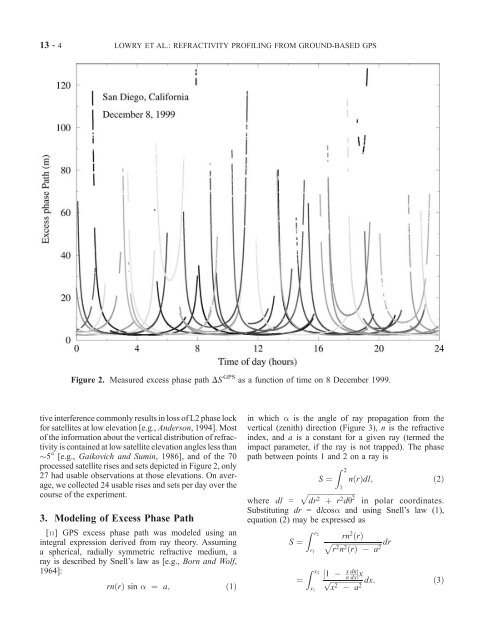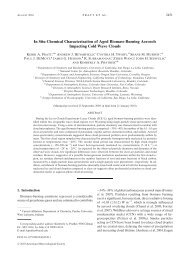Vertical profiling of atmospheric refractivity from ground-based GPS
Vertical profiling of atmospheric refractivity from ground-based GPS
Vertical profiling of atmospheric refractivity from ground-based GPS
You also want an ePaper? Increase the reach of your titles
YUMPU automatically turns print PDFs into web optimized ePapers that Google loves.
13 - 4 LOWRY ET AL.: REFRACTIVITY PROFILING FROM GROUND-BASED <strong>GPS</strong><br />
Figure 2. Measured excess phase path DS <strong>GPS</strong> as a function <strong>of</strong> time on 8 December 1999.<br />
tive interference commonly results in loss <strong>of</strong> L2 phase lock<br />
for satellites at low elevation [e.g., Anderson, 1994]. Most<br />
<strong>of</strong> the information about the vertical distribution <strong>of</strong> <strong>refractivity</strong><br />
is contained at low satellite elevation angles less than<br />
5° [e.g., Gaikovich and Sumin, 1986], and <strong>of</strong> the 70<br />
processed satellite rises and sets depicted in Figure 2, only<br />
27 had usable observations at those elevations. On average,<br />
we collected 24 usable rises and sets per day over the<br />
course <strong>of</strong> the experiment.<br />
3. Modeling <strong>of</strong> Excess Phase Path<br />
[11] <strong>GPS</strong> excess phase path was modeled using an<br />
integral expression derived <strong>from</strong> ray theory. Assuming<br />
a spherical, radially symmetric refractive medium, a<br />
ray is described by Snell’s law as [e.g., Born and Wolf,<br />
1964]:<br />
rnðrÞ sin a ¼ a;<br />
ð1Þ<br />
in which a is the angle <strong>of</strong> ray propagation <strong>from</strong> the<br />
vertical (zenith) direction (Figure 3), n is the refractive<br />
index, and a is a constant for a given ray (termed the<br />
impact parameter, if the ray is not trapped). The phase<br />
path between points 1 and 2 on a ray is<br />
S ¼<br />
Z 2<br />
1<br />
nðrÞdl;<br />
ð2Þ<br />
pffiffiffiffiffiffiffiffiffiffiffiffiffiffiffiffiffiffiffiffiffiffiffiffiffiffi<br />
where dl = dr 2 þ r 2 dq 2 in polar coordinates.<br />
Substituting dr = dlcosa and using Snell’s law (1),<br />
equation (2) may be expressed as<br />
S ¼<br />
¼<br />
Z r2<br />
r 1<br />
rn 2 ðrÞ<br />
pffiffiffiffiffiffiffiffiffiffiffiffiffiffiffiffiffiffiffiffiffiffiffiffiffiffiffi<br />
dr<br />
r 2 n 2 ðrÞ a 2<br />
Z x2 x dn<br />
½1 n dx<br />
ffiffiffiffiffiffiffiffiffiffiffiffiffiffiffiffiffiffi<br />
Šx<br />
x 1<br />
p dx; ð3Þ<br />
x 2 a 2






